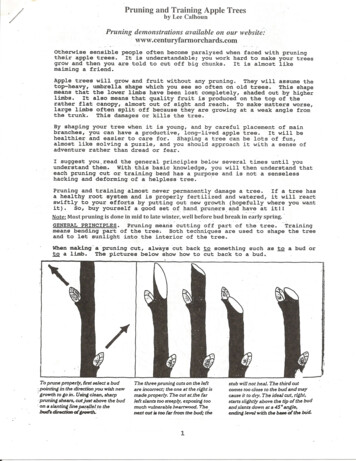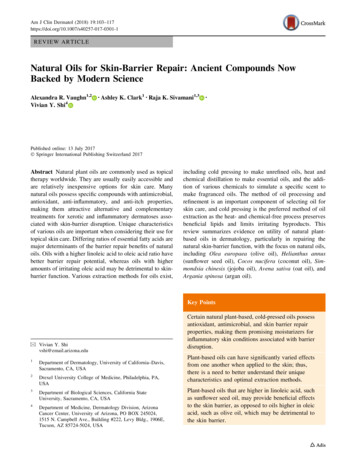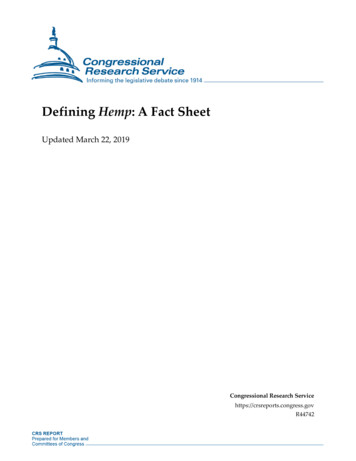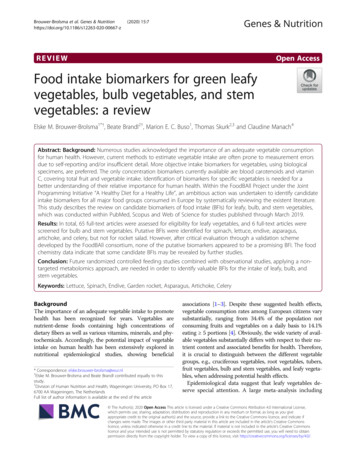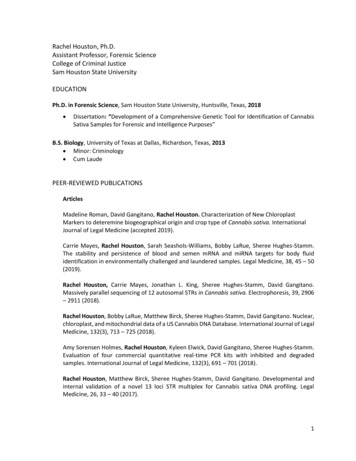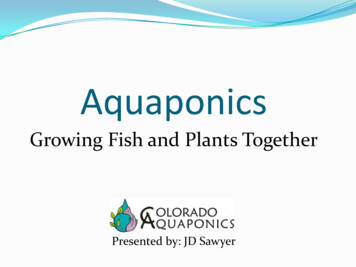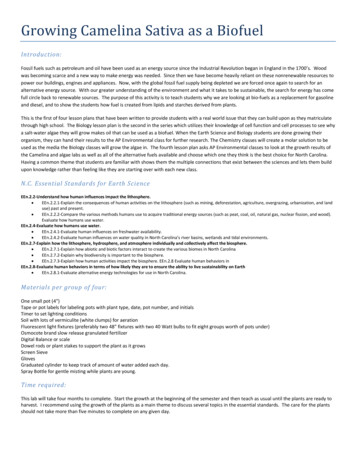
Transcription
Growing Camelina Sativa as a BiofuelIntroduction:Fossil fuels such as petroleum and oil have been used as an energy source since the Industrial Revolution began in England in the 1700’s. Woodwas becoming scarce and a new way to make energy was needed. Since then we have become heavily reliant on these nonrenewable resources topower our buildings, engines and appliances. Now, with the global fossil fuel supply being depleted we are forced once again to search for analternative energy source. With our greater understanding of the environment and what it takes to be sustainable, the search for energy has comefull circle back to renewable sources. The purpose of this activity is to teach students why we are looking at bio-fuels as a replacement for gasolineand diesel, and to show the students how fuel is created from lipids and starches derived from plants.This is the first of four lesson plans that have been written to provide students with a real world issue that they can build upon as they matriculatethrough high school. The Biology lesson plan is the second in the series which utilizes their knowledge of cell function and cell processes to see whya salt-water algae they will grow makes oil that can be used as a biofuel. When the Earth Science and Biology students are done growing theirorganism, they can hand their results to the AP Environmental class for further research. The Chemistry classes will create a molar solution to beused as the media the Biology classes will grow the algae in. The fourth lesson plan asks AP Environmental classes to look at the growth results ofthe Camelina and algae labs as well as all of the alternative fuels available and choose which one they think is the best choice for North Carolina.Having a common theme that students are familiar with shows them the multiple connections that exist between the sciences and lets them buildupon knowledge rather than feeling like they are starting over with each new class.N.C. Essential Standards for Earth ScienceEEn.2.2-Understand how human influences impact the lithosphere. EEn.2.2.1-Explain the consequences of human activities on the lithosphere (such as mining, deforestation, agriculture, overgrazing, urbanization, and landuse) past and present. EEn.2.2.2-Compare the various methods humans use to acquire traditional energy sources (such as peat, coal, oil, natural gas, nuclear fission, and wood).Evaluate how humans use water.EEn.2.4-Evaluate how humans use water. EEn.2.4.1-Evaluate human influences on freshwater availability. EEn.2.4.2-Evaluate human influences on water quality in North Carolina’s river basins, wetlands and tidal environments.EEn.2.7-Explain how the lithosphere, hydrosphere, and atmosphere individually and collectively affect the biosphere. EEn.2.7.1-Explain how abiotic and biotic factors interact to create the various biomes in North Carolina EEn.2.7.2-Explain why biodiversity is important to the biosphere. EEn.2.7.3-Explain how human activities impact the biosphere. EEn.2.8 Evaluate human behaviors inEEn.2.8-Evaluate human behaviors in terms of how likely they are to ensure the ability to live sustainability on Earth EEn.2.8.1-Evaluate alternative energy technologies for use in North Carolina.Materials per group of four:One small pot (4”)Tape or pot labels for labeling pots with plant type, date, pot number, and initialsTimer to set lighting conditionsSoil with lots of vermiculite (white clumps) for aerationFluorescent light fixtures (preferably two 48” fixtures with two 40 Watt bulbs to fit eight groups worth of pots under)Osmocote brand slow release granulated fertilizerDigital Balance or scaleDowel rods or plant stakes to support the plant as it growsScreen SieveGlovesGraduated cylinder to keep track of amount of water added each day.Spray Bottle for gentle misting while plants are young.Time required:This lab will take four months to complete. Start the growth at the beginning of the semester and then teach as usual until the plants are ready toharvest. I recommend using the growth of the plants as a main theme to discuss several topics in the essential standards. The care for the plantsshould not take more than five minutes to complete on any given day.
Pre-Lab Instructions:Due to the length of the growing time necessary for this organism, I recommend completing the pre-lab when you begin teaching any of thestandards listed below and have the students begin to grow their Camelina Sativa at the beginning of the semester. Each day the students willneed to come in and care for their plant by checking the soil moisture and watering as needed. This will preferably be done before the class begins,but no longer than 5 minutes after class has started. The biggest challenge with growing these plants will be during extended breaks such asHolidays or long weekends. I recommend having the groups assign a “Head Gardener” who is responsible for either delegating who will take theplant home on longer breaks, or for coming to the school to water if possible. Placing the plant by a 60 Watt compact fluorescent lightbulb andnext to a window for a couple of days will provide the plant with enough light until it can be placed back under the fluorescents for the 14 hourlight/10 hour dark timers. If you are planting during the fall semester, start as early as possible to use the December Holiday break as the dryingperiod.The pre-lab worksheet uses the free GREET software available from the Argonne National Laboratory. This software will enable you to choose anybiofuel along with gasoline and low sulfur diesel and compare their impact on the environment throughout the life cycle of the fuel from plantingall the way to the vehicle exhaust. This worksheet is designed to fit into the unit on atmosphere and air pollution. If you start the year with thattopic and then proceed to the geosphere, biosphere, and hydrosphere in any order then you can connect the growth of your Camelina plants asyou go. The students can talk about the geosphere through the effects of mining and fossil fuels, farming, soil, and land pollution to get a betterunderstanding of why we are looking at Camelina as an alternative. The lesson plan connects to the biosphere by teaching students about howenergy from the sun goes through the food chain and provides us with oils that can be converted to fuel. It even allows students the opportunityto figure out what alternative energy would fit best in various biomes.Post-Lab Instructions:The Post-Lab is designed to incorporate Science Literacy into an Earth/Environmental Science class. The student worksheet was created with theassistance of Sara Overby, our Wake County literacy Coach, to offer options for the teacher to differentiate between classes with each sectionrequiring more in-depth understanding than the previous one. For example, an Honors Earth/Environmental class could be assigned the post-labas a homework assignment, and an Academic class could do part 1 or 2 on their own and then discuss with the class the answers to part 3. Thearticle is a good brief overview of the potential of Camelina as well as the issues that are associated with growing plants as a biofuel and is attachedas a PDF file.Here is the link to the Camelina Article to be used for the Post-Lab from the Center for New Crops and Plant Products at Purdue /pilgeram129-131.pdfHere is the link to the Center for New Crops and Plant Products which has more Camelina Sativa articles for reference if desired:www.hort.purdue.edu/newcrop/nexus/camelina sativa nex.htmlIn addition to the Post-lab worksheet, I have included a Class Comparison Data Sheet after the growth record chart to allow the students to assesstheir success at growing Camelina Sativa and to make suggestions as to how to produce better results with future classes. This should assist withany modifications to your growing schedule that you need to make.Author Info:Mark TownleyI am a 14 year National Board Certified Teacher and Kenan Fellow working as an AP Environmental/Earth Science teacher at Holly Springs HighSchool in Wake County. I have a degree in Geology from North Carolina State University and am General Science Certified. In 2009, I was a finalistfor the Wake County Teacher of the Year, and was named as the N.C. Outstanding Science Teacher of the Year for District 3 by the N.C. ScienceTeacher Association in 2011. I have assisted with the development and implementation of multiple state-wide curricula including two from theN.C. Environmental Education Fund titled “It’s Our Water!” and “It’s Our Air!,” and was an original member of the NSF funded EarthView programback in 2000 when Earth Science became a graduation requirement.
Student Pre-Lab Worksheet for Growing Camelina sativa as a Bio-fuelCamelina-basedBD20BaselineConventionaland LS DieselYear: 2010Baseline CG andRFGLook at Figure 1 and answer the following questions:Total Energy225,759200,231366,954WTP Efficiency81.6%83.3%73.2%Fossil tural 6CO2 (w/ C in VOC & 230.2205.990GHGs19,43219,9396,791VOC: Total27.3658.10817.931CO: Total12.22911.79615.662NOx: Total47.62946.20053.575PM10: Total7.4856.8517.175PM2.5: Total4.0303.8274.223SOx: Total26.90725.71331.530VOC: Urban15.8973.4402.952CO: Urban3.5013.5513.016NOx: Urban9.7199.7668.506PM10: Urban1.9051.9281.630PM2.5: Urban1.1591.1700.998SOx: Urban9.3659.3058.195Figure 1: Avg. Emissions from passenger vehicles using conventional gasoline (CG), low sulfur (LS) diesel, and CamelinaChart from GREET software downloaded from the Argonne National LaboratoryThe chart above shows a comparison between the emissions from vehicle exhaust of three different fuel choices. The first two choices areConventional Gasoline (CG) and Low Sulfur (LS) Diesel which are made from non-renewable fossil fuels. The third fuel is a renewable biodiesel madefrom the Camelina Sativa plant that you are going to grow for this lab. Look at the chart above and answer the following questions as a classdiscussion or as homework.1. The two types of gases that cause photochemical smog and tropospheric ozone to form are Nitrous Oxides (NOx) and Volatile OrganicCompounds (VOC). Look at the VOC: Urban and the NOx: Urban comparisons between Conventional Gasoline, Low Sulfur Diesel, andCamelina. Will using Camelina Based Fuels reduce the amount of NOx and VOCs emissions from the car’s engine? What could this do foran Urban setting?2.Now look at the VOC: Total and the NOx: Total comparisons. These numbers represent all of the emissions from these fuel typesthroughout the entire life cycle of the fuel from mining (CG and Diesel) or growing the crop (Camelina) all the way to the engine. Why doyou think Camelina is now higher than the other two fuels? What types of fuels do you think the farmers probably used in their tractorsto grow the Camelina?3.Why are scientists studying alternatives to fossil fuels like gasoline and diesel?4. What could scientists do with Camelina to make it a better choice as an alternative fuel?
Student Pre-Lab Worksheet Answer KeyCamelina-basedBD20BaselineConventionaland LS DieselYear: 2010Baseline CG andRFGLook at Figure 1 and answer the following questions:Total Energy225,759200,231366,954WTP Efficiency81.6%83.3%73.2%Fossil tural 6CO2 (w/ C in VOC & 230.2205.990GHGs19,43219,9396,791VOC: Total27.3658.10817.931CO: Total12.22911.79615.662NOx: Total47.62946.20053.575PM10: Total7.4856.8517.175PM2.5: Total4.0303.8274.223SOx: Total26.90725.71331.530VOC: Urban15.8973.4402.952CO: Urban3.5013.5513.016NOx: Urban9.7199.7668.506PM10: Urban1.9051.9281.630PM2.5: Urban1.1591.1700.998SOx: Urban9.3659.3058.195Figure 1: Avg. Emissions from passenger vehicles using conventional gasoline (CG), low sulfur (LS) diesel, and CamelinaChart from GREET software downloaded from the Argonne National LaboratoryThe chart above shows a comparison between the emissions from vehicle exhaust of three different fuel choices. The first two choices areConventional Gasoline (CG) and Low Sulfur(LS) Diesel which are made from fossil fuels. The third fuel is a biodiesel made from the Camelina Sativaplant that you are going to grow for this lab. Look at the chart above and answer the following questions either as a class discussion or ashomework.1.2.3.4.The two types of gases that cause photochemical smog and tropospheric ozone to form are Nitrous Oxides (NOx) and Volatile OrganicCompounds (VOC). Look at the VOC: Urban and the NOx: Urban comparisons between Conventional Gasoline, Low Sulfur Diesel, andCamelina. Will using Camelina Based Fuels reduce the amount of NOx and VOCs emissions from the car’s engine? What could this do foran urban setting?Yes, especially with volatile organic compounds. This would reduce the amount of smog and ozone created in heavily populated citiesimproving air quality, lowering respiratory disease, and improving conditions for plant growth.Now look at the VOC: Total and the NOx: Total comparisons. These numbers represent all of the emissions from these fuel typesthroughout the entire life cycle of the fuel from mining (CG and Diesel) or growing the crop (Camelina) all the way to the engine. Why doyou think Camelina is now higher than the other two fuels? What types of fuels do you think the farmers probably used in their tractorsto grow the Camelina?Fossil Fuels are used to make plastics as well as fuel for combustion engines so with all of the equipment used to grow Camelina fromseed to harvest there is considerably more fossil fuels used throughout the life cycle. Farmers typically use gasoline in their tractors.Larger tractors and transport vehicles typically use diesel.Why are scientists studying alternatives to fossil fuels like gasoline and diesel?There are a number of possible answers such as lessening our reliance on foreign oil, reducing toxic emissions from vehicle exhaust,reducing human impact on global warming, switching from nonrenewable to renewable resources, etc.What could scientists do with Camelina to make it a better choice as an alternative fuel?Scientists could genetically modify Camelina to grow in multiple climates and produce more oil per acre of land. We could also usealternatives to fossil fuels in plastics and combustion engines so that the life cycle of Camelina has a smaller carbon footprint.
Instructions for Growing Camelina Sativa:Planting the Camelina Sativa seeds:See video of the NCSU Greenhouse Technician talking to me about planting1.) Place the Camelina Sativa seeds in a sealed test tube or vial with water and place them in a refrigerator for vernalization over a couple ofdays or over a weekend. Vernalization is the ability a plant develops for their seeds to germinate after the chill of winter. Placing theseeds in the refrigerator mimics the process of winter chilling and allows the water to penetrate the seed coat. The seed will absorb thewater and they will get a gel like coating around it. They are now more permeable and ready to grow.2.) Create a space for Camelina to grow and hang four 40 Watt fluorescent light bulbs 6 inches from the top of three 4 inch pots. I originallyused wire mesh shelving so that I could adjust the height of the shelves and the distance to the light as the plants grew. After gettingsome materials donated from our local nursery and hardware store, our construction class built us two 6ft. 10in. mobile growing stationsout of wood with the fixtures attached to the underside of the top and middle shelves so that we could move the growing stations whenneeded in the elevator to another floor or to another classroom.3.) After the seeds have vernalized, use a 250mL graduated cylinder and wet some vermiculite rich soil down in a large tub and gently mixthe soil with your gloved hands until the soil is moist and clumps a little bit. Do not squeeze the soil too hard, the more aeration thebetter.4.) Place the soil into the 4-inch diameter pots. Once again, do not mash the soil down so that the aeration will help with the developmentof the seeds. Use the tape to label the pots with Camelina Sativa, group name, date planted, and pot number.5.) Weigh a tablespoon of Osmocote Fertilizer and RECORD THE MASS IN THE GROWTH CHART. Place the tablespoon of Osmocote fertilizeron the top of the soil and water the soil slowly until water comes out the bottom of the pots. Move the Osmocote around with a smallspatula until it is just peeking out of the soil.6.) Place 10 seeds on the surface of the pots and spread them around gently with a small spatula. Do not push the seeds in the soil with thespatula; just let the soil cover it slightly as you spread the seeds. Camelina will germinate about 60% of the time under normalconditions. This means that 8-10 seeds can successfully germinate four or five plants per 4” pot with very little difficulty with a goodbatch.Growing the Camelina Sativa:1.) For the first three days, spray the pots with three squirts (approx. 3mL) of distilled water from a spray bottle twice a day or as needed andcover each pot with some clear plastic wrap until the seeds start to germinate. KEEP TRACK OF AMOUNT OF WATER SPRAYED EACH DAYON YOUR GROWTH RECORD.2.) On Fridays, using a 250mL beaker, gently pour water around the plants until the water begins to seep out of the bottom of the pot intothe tray. The plants should not need water for a couple of days after this application. Water the plants in this manner as necessary.KEEP TRACK OF THE AMOUNT OF WATER POURED ON YOUR GROWTH RECORD.3.) On the growth chart, write down the number of leaves on your plant as it grows and make observations on the plant health, color, andstability.4.) When the plants get more than a few inches tall, use the wooden dowel rods and some string to LOOSELY support the stalks. Continue towater as needed. The easiest way to kill these plants would be to overwater! If the soil is still really moist, then wait until the next day towater.5.) The plants will tend to flower between 24-27 leaves.6.) Once the pods appear, do not be concerned if the leaves or the stalk begins to yellow because that means that most of the energy isgoing towards the production of oil and seeds and you will be able to harvest soon.Procedure for Harvesting Camelina Sativa:1.) Once the pods start to turn yellow, the plants are almost ready to harvest. You may see the leaves at the bottom start to go throughsenescence (aging and withering) which means that the plant has used all of the nutrients from the osmocote and is focusing its energyon making the seeds.2.) Once the pods start to yellow, stop watering and let the plant dry out for one to two weeks. When all of the pods are dry, brittle, and astraw yellow color then they are ready to harvest. The pods do not shatter which makes it easier to harvest.3.) Use a Screen Sieve that has 14 holes per square inch and place it on top of a piece of white paper.4.) Holding the Camelina over the sieve, pinch a branch between your thumb and index finger and slowly slide and pull the pods off of thebranch into the sieve. Try and pinch the pods open as you go. Do this until all of the pods are in the sieve.5.) Go through the sieve and make sure that all of the pods are open and tap the sides of the sieve to work the seeds through to the whitepaper beneath.6.) Remove the sieve and clean anything that is not a seed out of the seed pile on the white paper.7.) Mass the weight of the seeds.If you have access to a seed press, then the oil your students produce could be made very easily into a biodiesel! Call theBiofuels Center of North Carolina in Oxford for more information at 919 693-3000. If your students don’t have enoughseeds to convert, then you can pur chase Camelina oil at your local nursery for less than 10.00. There are also severalkits that you can order to safely convert oil to diesel through most science catalogs.
Student Worksheet for Post Lab: Connecting with the TextPilgeram, et al., “ Camelina sativa, A Montana Omega-3 and Fuel Crop”Directions:As you read, respond to these statements with True or False. Some of them have a definite T/F answer. Some of them expect you to make anevaluation of the information and record your reasoned opinion.Level 1: Answer True or False. Provide the page/paragraph number from the text that supports your answer.1. The camelina breeding program run by Duane Johnson of Montana State University is developingthe best cultivars for the Montana growing area by selecting plants through 4 main criteria.2. Camelina can also be used to enrich eggs and milk for human consumption, but it is especially good for enriching beef.3. Camelina plants have been cultivated by humans since the Bronze Age for use as food, fuel, and even spa treatments.4. One of the reasons that camelina is a good possibility for commercial production is that it doesn’t require very much seed toproduce a good yield, thus leading to lower production costs.5. One of the problems with camelina production for biodiesel is that camelina has many possible uses, and the agricultural uses forfood and feed might be more commercially valuable than its uses as a fuel source.Level 2: Answer True or False. Provide page/paragraph number from the text that best supports your answer.1. The authors of this article believe that Camelina sativa will give the best value for the moneyspent, even though it doesn’t always produce the greatest harvest, mainly because it requires so little time and money to produce.2. The “inverse correlation” of seed size and oil content mentioned by the authors suggests that ittakes the small size of camelina seeds produce a small amount of oil for biofuel and nutrition uses.3. The authors mention “selection criteria” several times. They are talking about developing a newversion of camelina by breeding the next generation of plants from parent plants with specific features.4. When the authors use the term agronomic, they are talking about the astronomic prices of camelinaseed.5. The main reason that camelina is valuable for human food consumption is its high omega-3 fattyacid content.Level 3: Answer True or False. Provide reasoning to support your answer.1. If the variant (cultivar) of camelina being developed at MSU were grown in North Carolina, farmerswould need to make sure that they planted it earlier than they might in Montana.And Why?2. When comparing the 3 variants of camelina being tested at MSU, it seems that the highest oilproduction will occur iffarmers grow the Ligena cultivar.And Why?3. Because of the taste of young camelina plants, farmers will not need to fence in their crops to protect it from deer.And Why?4. It will be fairly easy to convince agri-business owners to grow camelina solely for the purpose of developing biodiesel fuel.And Why?5. If Flannery, et al, had not previously conducted major research on Arabidopsis thaliana, the MSUresearchers would have a much easier time with their own research.And Why?
Answers for Post-Lab Student Worksheet: Connecting with the TextPilgeram, et al., “ Camelina sativa, A Montana Omega-3 and Fuel Crop”Directions:As you read, respond to these statements with True or False. Some of them have a definite T/F answer. Some of them expect you to make anevaluation of the information and record your reasoned opinion.Level 1: Answer True or False. Provide the page/paragraph number from the text that supports your answer.T-130/41. The camelina breeding program run by Duane Johnson of Montana State University is developingthebest cultivars for the Montana growing area by selecting plants through 4 main criteria.F-131/42. Camelina can also be used to enrich eggs and milk for human consumption, but it is especially good for enriching beef.T-129/13. Camelina plants have been cultivated by humans since the Bronze Age for use as food, fuel, and even spa treatments.T-130/14. One of the reasons that camelina is a good possibility for commercial production is that it doesn’t require very much seedto produce a good yield, thus leading to lower production costs.T-130/25. One of the problems with camelina production for biodiesel is that camelina has many possible uses, and the agriculturaluses for food and feed might be more commercially valuable than its uses as a fuel source.Level 2: Answer True or False. Provide page/paragraph number from the text that best supports your answer.T-129/21. The authors of this article believe that Camelina sativa will give the best value for the money spent, even though it doesn’talways produce the greatest harvest, mainly because it requires so little time and money to produceF-130/32. The “inverse correlation” of seed size and oil content mentioned by the authors suggests that ittakes the small size of camelina seeds produce a small amount of oil for biofuel and nutrition uses.F-130/23. The authors mention “selection criteria” several times. They are talking about developing a newversion of camelina by breeding the next generation of plants from parent plants with specific features.F-130/14. When the authors use the term agronomic, they are talking about the astronomic prices of Camelina seed.T-131/15. The main reason that camelina is valuable for human food consumption is its high omega-3 fattyacid content.Level 3: Answer True or False. Provide reasoning to support your answer.T1. If the variant (cultivar) of camelina being developed at MSU were grown in North Carolina, farmerswould need to make sure that they planted it earlier than they might in Montana.And Why? Plants grow earlier in the warmer climates of North Carolina, so you would need to plant earlier to avoid increased pesticide use,and competitive weeds.F2. When comparing the 3 variants of camelina being tested at MSU, it seems that the highest oil production will occur iffarmersgrow the Ligena cultivar.And Why? According to Fig. 2 on pg. 130, MT-5 will produce the most oil. Ligena is the lowest amongst the cultivars.F3. Because of the taste of young camelina plants, farmers will not need to fence in their crops to protect it from deer.And Why? Pg 130/1 The palatability of the crop when green is not lost on grazing animals. This means that farmers will likely have toprotect their crops from deer.F4. It will be fairly easy to convince agri-business owners to grow camelina solely for the purpose of developing biodiesel fuel.And Why? Camelina is too valuable as a feed-stock to convince most agri-business to focus on biodiesel only.F5. If Flannery, et al, had not previously conducted major research on Arabidopsis thaliana, the MSUresearchers would have a much easier time with their own research.And Why? Camelina is the closest relative to the well studied Arabidopsis, which makes breeding, identifying specific enzymes, and anygenetic modifications much simpler if needed.
Camelina Sativa Wild Type Growth RecordDate of planting: Group Names:Lighting conditions:Mass of Fertilizer used: Total Amount of Water Used:Mass of Harvested Seeds:Day01234567Number of leavesper plantObservations(height, health, color, atmosphericconditions, etc.)Amount ofwater added inmLInitials
8910111213141516171819
202122232425262728293031
323334353637383940414243
444546474849505152535455
565758596061626364656667
686970717273747576777879
808182838485868788899091
9293949596979899100101102103
104105106107108109110111112113114115
116117118119120
Class Comparison of Growth Data1.2.3.4.5.What was the highest amount of water that was used by a group in the class? What was the least amount of water used bya group? Were they successful in growing their plants to maturity?Most:Least:What was the total mass of seeds for the class?What was the average mass of seeds per group?Graph the relationship between the mass of seeds that were produced and the amount of water that was used by eachgroup. Use two lines on the graph below with the group numbers on the x-axis and the mass of seeds and the amount ofwater used on the two y-axes.Do you have any suggestions for future classes to be more successful with growing Camelina?
a salt-water algae they will grow makes oil that can be used as a biofuel. When the Earth Science and Biology students are done growing their organism, they can hand their results to the AP Environmental class for further research. The Chemistry classes will create a molar solution to be used as the media the Biology classes will grow the algae in.


